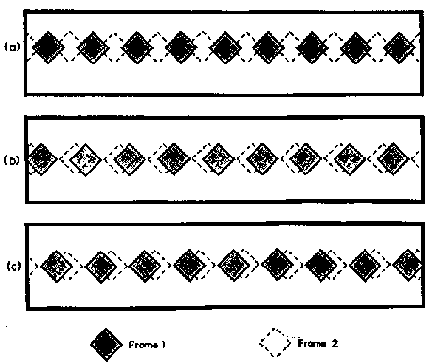Vison Research Vol. 32, No.
6, pp. 1137-1141, 1992
Lateral Motion Bias Associated with
Reading Direction
Kazunori Morikawa, Michael K. McBeath
We found that when Americans view ambiguous lateral long-range apparent
motion, they exhibit a robust bias to experience leftward movement. In
successive experiments, right-handers and left-handers, and left-side drivers
from Japan equally manifested this leftward bias. However, bilingual viewers
whose first language reads from right to left exhibited no lateral bias.
Furthermore, the bilingual sample produced a significant correlation between
exposure to English and extent of leftward motion bias. The finding provide
strong evidence that reading habits can influence directionality in motion
perception.
 |
FIGURE 1. Stimuli used in the experiments.
(a) The test condition. Because the second frame is spatially shifted by
exactly a cycle from the first frame, we refer to it as the neutral-shift
condition. (b) The left-shift condition. (c) The right-shift condition.
In the latter two conditions the second frame is shifted in the specified
direction by a quarter cycle. |
 |
FIGURE 2. Magnitude of bias was
defined as number of rightward responses minus number of leftward responses
for each subject. Each bar indicates the mean of 8 subjects. Negative scores
indicate leftward bias. Error bars equal +/-1 SEM.
The native language of the top two groups is English. Left side drivers
are native Japanese whose first language reads left to right. Thus, the
top three groups also represent left-to-right readers as opposed to the
fourth group whose first language reads right to left. The Japanese sample
also provides a bilingual control in which both languages read left to
right. |
Go to Top of Page
Go
to McBeath
Research Page
Go to McBeath
Home Page

